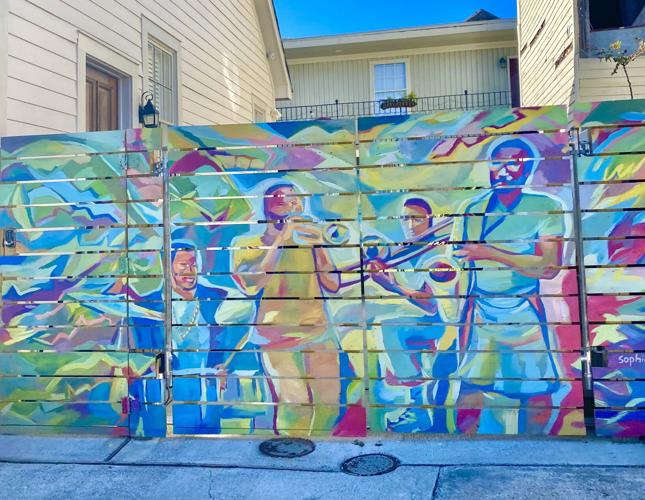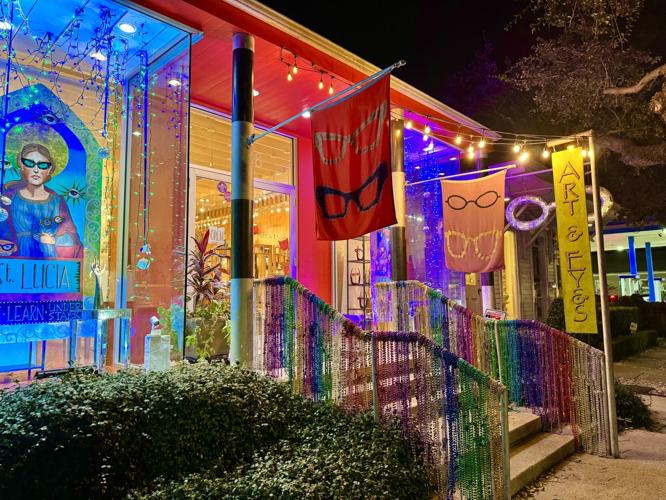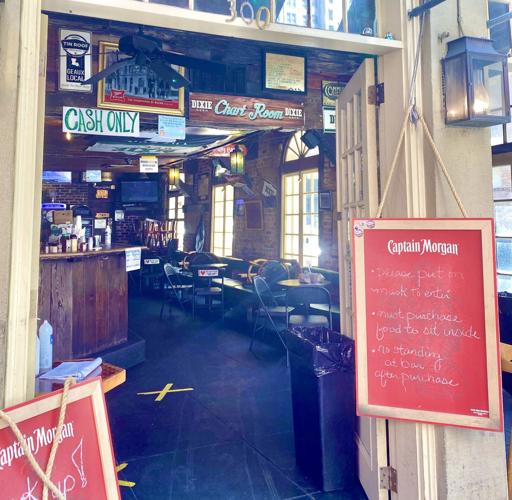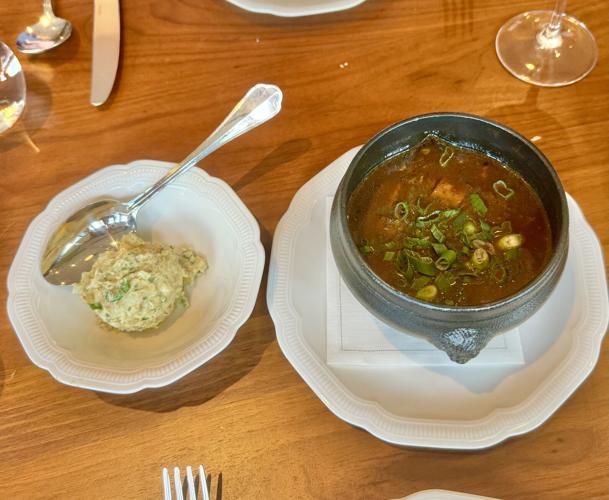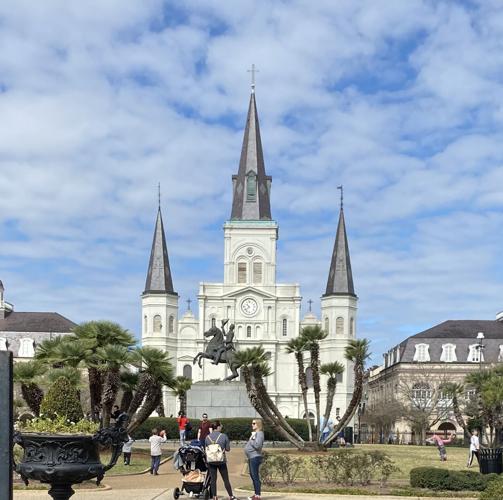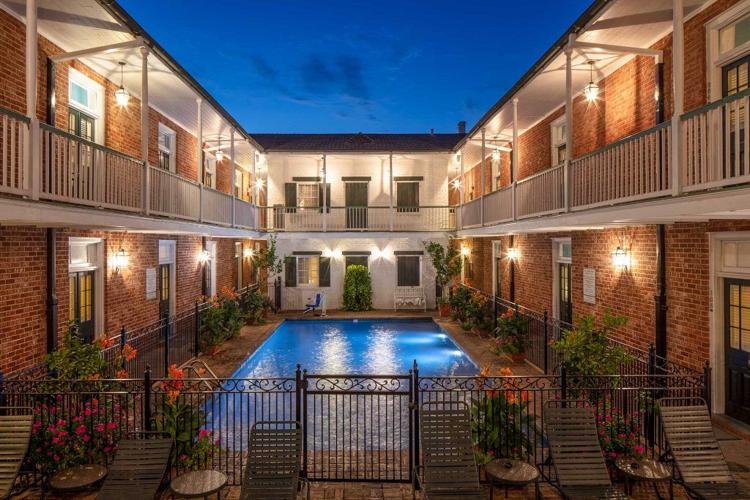
A mural outside a home in Tremé
As someone who went to New Orleans before I went to kindergarten, I’m always surprised how many Nashvillians have never been. But I’m never surprised that the Nashvillians who have been always go back.
Nashville and New Orleans have all the obvious things in common: music, food, culture, booze, art, tough history, architecture and tourism that locals love and hate in equal measure. Obviously, they’re more adept and chill about the latter since they’ve been dealing with it for decades, but it’s easy to see why people who love one city often love the other, and why many businesses — Barrel Proof, Rice Vice, Turkey and the Wolf — choose to set up outposts of their flagships in the other.
So the next time you’re looking for somewhere to spend three days, here’s how to do it.

A home in the French Quarter
1. How to Get There and When to Go
At 530 miles away, New Orleans is too far to drive. It’s eight-plus hours by car, and that’s a horrifying distance if you’re over 25. But it’s a quick hour-and-30-minute flight via Southwest. According to BNA, 251 people travel from NOLA to Nashville each day, each way. However, only half of those seats are filled every week, so if you travel on a Tuesday night or Thursday morning, you can spread your merry ass out over a whole aisle.
As for when to go, if you’re over 25, skip Mardi Gras. Unless you’ve got a friend in a krewe or you’re invited on a float (which you’ll pay handsomely to ride), Mardi Gras is an anomaly for a city known as The Big Easy. Is it a glitzy, glorious, messy blast? Absolutely. Did I once lose my wallet, phone, boyfriend and hotel all during one parade? Perhaps. (Don’t worry — I found the important one: my wallet.) But again, all of that went down in my 20s.

This is a random store not during Mardi Gras. You’ll see your fair share of sparkle anytime.
For any other age groups, I suggest hitting the city:
- In the month leading up to Fat Tuesday, when local krewes hold smaller parades in neighborhoods and bars start to decorate. You’ll get the gist without getting puked on.
- Fall. It won’t shock you to learn that Halloween in New Orleans is A Thing, but it might surprise you that the time between Thanksgiving and Christmas is also wonderful. Like Nashville, it’s cold but not frigid, so you can still walk around, and you get to enjoy the French Quarter dolled up for Christmas.
- Annual events that aren’t Mardi Gras. Jazzfest has been one of spring’s biggest celebrations for more than 50 years. Southern Decadence is the largest LGBTQ event in the city every Labor Day. And the Essence Festival, the largest African American culture and music event in the U.S., is celebrating its 30th anniversary this July. Whatever crew you belong to, they gather in New Orleans.
2. Where To Stay
Call me a tourist and a basic bitch, but I stay in the French Quarter. I know — the Garden District is gorgeous, you’ve got to Magazine Street or Mid-City for a lot of great food, and you hit the Bywater or Marigny for music and art.
But in terms of where to stay? I don’t care! I want the gas lamps and bad fortune tellers and bumpy streets to twist my ankle on. I want to walk out in the morning to wet streets that have just had God-knows-what hosed off them and smell stale beer and beignets because then and only then do I know I’m in New Orleans.
Here are two spots I love:
Inexpensive and Historic: Hotel Provincial
One of the keys to staying in the Quarter is to do it on the outskirts. You know how, when you walk just a few blocks away from Lower Broadway, you can’t hear the squawks of a party tractor? The same is true of the French Quarter, but that sense of serenity is even better there because, if you find the right street to stay on, you feel like you’ve stepped back in time.

Take the Hotel Provincial. Several of its five buildings date back to the 1800s, and a military hospital stood on the land during the Civil War. Today it offers the Platonic ideal of New Orleans — courtyards, a pool, local art throughout, and a quirky little bar that feels more like you’re in some rich, old (nice) socialite’s home than in a hotel. My favorite part, though, is the French doors you can fling open dramatically to let in that sweet Suth’un breeze. Even in the winter, I open every window so all the drapes flutter wildly like a damn Meat Loaf video, and it is glorious.
High-End and Historic: Four Seasons
If you lean more toward modern or high-end accommodations, you typically have to forego historical significance. Not in New Orleans. The building that houses the Four Seasons, which opened in 2021, was home to the World Trade Center when it opened in 1968. It was designed by Edward Durell Stone, an American architect who designed places like the Museum of Modern Art. The city almost demolished the building a few years back until a local group swooped in to save it, and now you can stay in this piece of New Formalist history (or at the very least walk through it and gawk at some fine art and architecture).

As you’d expect, the details in this place are thoughtfully bonkers — and they better be since the renovation ran a cool half-billion dollars.
- Stone designed the building with a compass shape, so each wing points a cardinal direction to symbolize New Orleans’ importance in international trade. (The building was also originally home to the port of New Orleans.)
- The lobby is stunning, leveraging the building’s original marble columns, which set off potted tropical plants, louvered screens and the most gobsmacking chandelier you’re going to find outside of Liberace’s bedroom.
- Every corner of the building teems with local and international art, from Louisiana-based artist George Dunbar’s clay-and-gold-leaf panels in the lobby to MaPó Kinnord’s garden sculpture reflecting the traditions of West Africa.
- Even the guest rooms display an insane level of thought, with plaster reliefs of regional plants in place of headboards, and white oak accents throughout. (If you’ve ever seen a film set in New Orleans, you’ve seen these exquisitely twisty and elegant trees.)

Why should you care if you’re just going to sleep there? Cultural osmosis. You know how people come to Nashville and get so swept up in music and food and partying that they end up just partying the whole time? Well, New Orleans invented that. But if you make sure you stay somewhere with culture or history built in, you’ll feel better about yourself upon departure. (At least emotionally — I can’t help your body or your bank account.)
Bonus: Because there’s such high hotel inventory in New Orleans, even places like the Four Seasons run specials (not to mention insane experiential add-ons like Oysters Take Flight), and you can nab places like Hotel Provincial for as low as $110/night on weekdays.
3. What to Do
For purposes of this exercise, we’re going to focus on five things you can do in the Quarter that we’ve got nothing like in Nashville.

At the Audobon Insectorium
Audubon Insectarium
Attached to the (very good) aquarium where you must pet a stingray, you’ll find the insectarium — a thing I did not know existed that I did not want to visit. If it doesn’t have fur, I’m not interested, but this place is worth a spin for the butterfly garden alone. The room, which overlooks the river, is filled with hundreds of free-flying butterflies from rainforests around the world that will come and perch right on your shoulder. This experience is empirically cool, as long as you are not my 2-year-old, who immediately decided butterflies are her mortal enemies and lost her ever-loving shit. But guess what. If you too decide you hate insects with a fiery passion, the museum offers insect cuisine, so you can show them who’s boss by eating them. (No, not the butterflies, to my daughter’s dismay.)
National WWII Museum
This renowned museum was originally known as The National D-Day Museum, which you probably heard a lot about recently as we commemorated the 80th anniversary of D-Day on June 6. I’m not much of a History Guy — Tom Hanks gets my money only from Toy Story sequels — but the gist is this: On June 6, 1944, Allied forces invaded the beach at Normandy, France, with more than 150,000 troops as part of a prolonged and ultimately successful campaign to liberate northwest Europe. Roughly 40,000 soldiers died in the pivotal battle, which is now considered the greatest amphibious landing in history. Even I, a military idiot for the ages, get goosebumps imagining the kind of planning and guts and bravery that one day took. If you are someone who knows a lot about this kind of history, you need to go to this museum. If you are someone like me — who knows very little but whose grandfather, Roy Harding Koger, served in the liberation of Germany — you need to go even more.

Jackson Square
Jackson Square
Originally called the Place d'Armes — aka “weapons square” — this central hub is where you’ll find artists, performers, musicians, dancers, etc., with varying levels of talent, much like you’d find up and down Lower Broadway here. Another thing that’ll feel like home: the big statue of an old white man in the middle, who is actually Tennessee’s own Andrew Jackson! The square is named for him because he apparently did a bunch of hero shit during the Battle of New Orleans (including convincing local pirates to help, which I admit is cool). You can take a self-guided tour of St. Louis Cathedral for just $1 (but donate more than that), and pop over to Café du Monde for beignets and coffee. Yes, it’s a tourist trap, but it’s also the real deal. And, yes, there are other locations, but the ambiance is all wrong at those, so you must come to this one.

You're going to want to stop by the store at the Pharmacy museum for this T-shirt alone.
Pharmacy Museum
This weird little museum checks a bunch of New Orleans boxes. First, it’s old, dating back to 1823. Second, it’s one of a kind, built by Louis J. Dufilho Jr., the first licensed pharmacist in the United States. Third, it’s architecturally significant as a "Creole townhouse," which replaced the wooden buildings that the Great New Orleans Fire of 1788 destroyed. You can spot these buildings all over town by their courtyards, thick walls, arcades, cast-iron balconies, steeply pitched roofs with parapets and facades sitting on the property line. I love this place because you can pop in any time for a tour for $15 or less, they’ve often got live music going in the courtyard, and there is quite literally nowhere else in the country you can see medical instruments, potions, herbs and 18,000 other items that’ll make you feel like you stepped right out of Practical Magic.
Preservation Hall
This is easily the biggest “duh” on this list, but if you’ve never been to New Orleans or you’ve never been here, you simply have to go. I am not a fan of skatty, skippity boo-bop, I-don't-know-where-this-is-going jazz, but this is not that. Much the same way someone might tell you they don’t like bluegrass and you’d insist they go to the Station Inn, anyone who enjoys — and appreciates — live music must experience Preservation Hall. It’s that clear a choice.
4. Where to Eat and Drink
Far more knowledgeable diners than I am have put together comprehensive guides to eating in New Orleans, so I’m just going to run down how I build an itinerary when I go. Again, for our purposes, I’m keeping it 90 percent in the Quarter because constraint is the only way this list won’t go on until Mardi Gras.
On every visit, pick at least one from each category:
A. A Fancy, Old-School, Blowout Meal
B. A Fun, Modern Meal
C. A Casual, Classic Stop
D. Upscale Cocktails
E. Serious Dive Bars

At Galatoire's
A. A Fancy, Old-school, Blowout Meal
Order the market fish with lemon-caper beurre blanc and the shrimp remoulade. If you think you can handle it, make a reservation for their legendarily raucous Friday lunch, and don’t bring your 2-year-old (though they will kindly pack up your bread pudding and cocktail if you are a dumb enough to try).
Still owned by fifth-generation relatives of founder Antoine Alciatore, this place claims to have invented Oysters Rockefeller, Eggs Sardou (poached eggs, artichoke bottoms with anchovies, hollandaise) and Pommes de Terre Soufflés (puffed potatoes). But here’s the thing: This is New Orleans, so all of that is probably true.

At Brennan's
In 1946, Irish immigrant Owen Brennan — whose sister would ultimately create Bananas Foster — opened the original iteration of this restaurant on Bourbon Street. When the restaurant moved over to Royal 10 years later due to rent hikes, defiant patrons paraded over in second-line fashion to the pink house where it now lives. Fun fact: That house was built by the great-grandfather of Edgar Degas back in 1795.
Kicking things off in 1918, Arnaud’s is one of the older restaurants in the Quarter, with 14 dining rooms, fourth-generation family owners, and an inventor’s claim on Oysters Bienville — a baked variety with cream sauce made with shrimp, mushrooms, bell peppers, sherry and cheese. The real showstoppers here, though, are the bars, namely the renowned French 75 which was men-only for a long time (rude) and which now, at $12, serves a cheaper Sazerac than you can find anywhere in Nashville.

At The Court of Two Sisters. If they don’t bring you the whole bottle of Sherry, they are doing it wrong.
The history of this property dates back to 1726, and the courtyard has supposedly seen everything from torchlit voodoo rites to Jean Lafitte, the “gentleman pirate,” supposedly killing three men in three separate duels in one night. Talk about time management! The Court of Two Sisters does a huge brunch business, but the food is better at other meals — though their turtle soup is always on point (and low-key the best in town).
B. A Fun, Modern Meal
The easiest way to go about this category is to hit some restaurant groups/chefs/owners who, quite frankly, don’t miss. Much like we’ve got Strategic Hospitality or Bryan Lee Weaver's Honest To Goodness Hospitality or Sean Brock's empire, New Orleans has these folks:

Fried oysters at Herbsaint
Donald Link and Link Restaurant Group
Donald Link is one of those guys who’s probably more comfortable butchering a hog than accepting a James Beard Foundation Award, though he’s done both. For bright, approachable seafood (think grilled tuna with okra, peanuts and tamarind), try Pêche, which is helmed by Memphian Ryan Pruitt, who also has his own JBFA. For the absolute perfect patio and world’s best fried oysters (which I typically DGAF about but which I ate all of), it’s gotta be his flagship Herbsaint. And if you just want to do some emotional cutting over the fact that Nashville can’t have nice things, go to the original Cochon Butcher and bemoan the fact that our outpost closed (though it did, at least, bring us Levon Wallace and his brilliant sandwich artistry).

Meze at Saba
Alon Shaya
I don’t know if Alon Shaya’s was the first Israeli food I’d ever had, but I do know it’s the best. The meze at Saba (which is Uptown, I admit) is the best I’ve had, just edging out our beloved Butcher & Bee. When Safta in Denver knocked me out, too, I was ready to drink the Flavor Aid. But nothing prepared me for Miss River. Designed to evoke the Garden District, it’s all delicate pinks and bronzes and stained glass, and overall the most dazzling place you can imagine — like eating in the middle of a piece of rose quartz.

Gumbo at Miss River
Shaya’s tribute to Louisiana cuisine is an embarrassment of riches, from the luscious, simple boudin (sourced from IYKYK Best Stop) with piquant mustard to the stout, flaming espresso martini to the luxurious bread pudding. But the thing he must’ve sold his soul for is the duck and andouille gumbo, which is made with a diabolically dark roux that’s just barely pulled out of being too rich by zingy scallions and zesty potato salad you can (and must) opt to have instead of rice. Miss River is a modern restaurant, to be sure, but the hospitality feels timeless in a way that only New Orleans can still do.

Miss River
Important notes:
- You can find Miss River at the base of the Four Seasons, and Donald Link’s latest venture, the impeccable Chemin à la Mer, with equally soaring seafood towers and views, just a few floors above, should you feel up to attempting the ultimate tag-team dining.
- If you want to eat Shaya’s food, you cannot, ironically, go to Shaya. The restaurant that bears his name no longer belongs to him because New Orleans can’t have nice things either.
Nina Compton
Yet another JBFA winner, this St. Lucian chef mixes the Caribbean flavors of her childhood with those of New Orleans at Compère Lapin (named for a mischievous rabbit in Caribbean folktales) in the Warehouse Arts District. Her food is unfussy and flavorful, with bright elements like papaya salad balancing out the heavier fried chicken with honey butter. If you make it to the Bywater, check out BAB, formerly Bywater American Bistro, for aperitifs and small plates.

The Warehouse District will also double as a walking tour of art with murals like this one by Brandan 'BMike' Odums.
Mason Hereford
This dude could not just do me a solid and have one place in the Quarter for purposes of this article, but I can’t talk about modern NOLA cuisine without him — especially when he’s headed to East Nashville. With a boisterous, no-bullshit vibe that’ll remind you of Redheaded Stranger (where they’ve popped up before) or Locust, Hereford garnered deserved national acclaim for flagship sandwich shop Turkey and the Wolf and its you’ve-gotta-taste-it-to-believe-it collard green melt. (I did, and I do.) Now they’ve got two more places on Magazine: a breakfast spot in Molly’s Rise and Shine and Hungry Eyes, the latter of which is a blast of ‘80s decor that’s kind of Beetlejuice-meets-The Max from Saved by the Bell.
The food is seriously good without taking itself seriously, from artichoke hearts on the half shell (morita chile, garlic, Parmesan) to the sweetbreads with peanuts, puffed rice, tamarind and bean sprouts. It’s one of those places where, with every bite you take, you look at the person you’re eating with and one of you goes, “Holy shit, you gotta try that.” There’s just no more fun way to eat.

Felix's
C. A Casual, Classic Stop
Chargrilled Oysters
This New Orleans staple is the best way to prepare big Gulf oysters that are actually not great to try take down in one bite raw. Everyone has their favorite, from Casamento’s on Magazine to Drago’s, which claims to be the originator. In the Quarter, people line up at one of two places: Acme or Felix’s. As for me and my house, we stand with Felix’s because it feels less corporate and delivers more consistently. However, like cheesesteaks in Philly or hot chicken here, tasting multiple versions and arguing about it is half the fun, so do that. Just don’t stand in line at noon on a Saturday like a chump; go at 3 p.m. on Thursday or 10 a.m. on Sunday for a dozen and a draft, and keep it moving.
Southern and Creole
The other 5 percent of that outside-the-Quarter loophole I gave myself comes in here because you’ve got to make the 1.5-mile pilgrimage to Tremé to hit either Willie Mae’s Scotch House or Dooky Chase's. While the matriarch of the latter, legendary Creole chef Leah Chase, passed away in 2019, her family still runs the spot that’s served everyone from Hank Aaron to Quincy Jones to Barack Obama, whom she fabulously threatened to slap for trying to put hot sauce in her gumbo. If you make the trek, you may also be able to hit Willa Mae’s — a bar turned barbershop turned restaurant — that’s got a JBFA American Classic Award (like Arnold’s and Prince’s) for soul food like their fried chicken, though they do sometimes close without warning for periods, as all old-school spots in NOLA retain the right to do.
Po’boys
Parkway is the undisputed king of po’boys, but I already used my 10 percent of non-Quarter food up, so I’m sending you to Mother’s for debris. As a Southerner, you know the history of the po’ boy, but you may not know why everyone is so hot and bothered about the specific type of bread they use in New Orleans. Made with less flour and more water than a traditional baguette, this wetter dough yields a lighter bread with crisp crust and fluffy center, which makes it better at soaking up sauce from debris (slow-cooked, gravy-like meat) or for smushing crunchy fried seafood.

At Napoleon House. You know you want to get weird in an 18th-century alcove.
Napoleon House
This is another famous spot that’s been living up to the hype since 1914. The building was erected in 1794 and got its name as part of a plan to bring Napoleon Bonaparte to New Orleans after his exile. (He up and died before they could give that a real go.) They do far more things well here than they need to (the club sandwich is lights out) but the draws are (1) their iconic Pimm’s Cup, which they were the first to sell in America and have sold more of than anywhere in the world (other than the London bar where the drink was invented), and (2) the muffaletta, which they heat — a preparation I believe they invented, and which is genius because it allows everything to melt into a pizza-like ooey-gooey goodness.

If you are a salt addict, seek out Jolie’s martini of olive-oil-washed Fords Gin, vermouth, Manzanilla sherry and MSG anchovy brine served with caviar and iced, pickled things.
D. Upscale Cocktails
You can find a hand grenade on any corner in the Quarter, but also a legit cocktail bar if you know where to look. Try Jewel of the South for something intimate and romantic, or The Will and the Way for fun snacks and vibrant drinks. Sylvain, which is in a carriage house built in the late 1700s, has a charming courtyard, robust food menu and bustling vibe. And, if you’re looking for something a littler newer and off the beaten path, there’s Jolie in the Warehouse District, which offers decor as sumptuous as its drinks.
E. Serious Dive Bars
You can’t talk about bars in the Quarter without mentioning Lafitte’s. The old blacksmith shop was built in the early 1700s and is, as such, the oldest structure used as a bar in the U.S. It escaped two great fires thanks to its slate roof, and served as home base for Gulf pirates the Lafitte Brothers’ smuggling operation in the 1790s. The famous drink here is the frozen Voodoo Daiquiri, which is an unholy mix of bourbon, grain alcohol and grape juice. It tastes as bad as it sounds and will make you feel even worse the next day. Get a local beer instead.

Chart ROom
More importantly, the Quarter has the inarguable holy trinity of dive bars in the following:
- The Alibi, because it is unassuming, right off Bourbon Street, and is good if you’re traveling with someone who’s likely to lose their phone and need a home base to return to. (See you there, Carson.)
- Erin Rose promises “Local prices. Local chaos. Local love,” and it delivers. It’s the originator of Frozen Irish Coffee, and this is the frosty, boozy concoction you’ve been waiting to spend all your calories on.
- Chart Room, like all the best dives, doesn’t have a website, they don’t take credit cards and they still sell cigarettes. It’s got French doors that open at the front, a jukebox, and the locals inside always outnumber the tourists. When I die, some of my ashes are to be spread here, if only in an ashtray.

Barrel Proof New Orleans
5. Enjoy NOLA in Nashville
If you can’t get to New Orleans, get a taste of Louisiana in Nashville at:
- Barrel Proof, a NOLA-born bourbon bar that’s semi-secretly just as skilled in margarita making as it is in whiskey pouring.
- Voodoo Gumbo, a small Bellevue shop run by brothers Joel and Herb Tassin, who made the move from New Orleans to Nashville after they tired of evacuating every time a storm hit the Gulf.
- Spicy Boy's and Icy Boy’s in East Nashville, the former of which is the only place that approximates the vibe of a St. Charles patio, and whose food can hold court.
- The Gumbo Bros., which actually hails from Baton Rouge but which delivers on a variety of stews, cocktails and special events.
- Fatbelly Deli, while not a place that claims any New Orleanian heritage, does serve the only hot muff I’d put in contention with Napoleon House.

